return to homepage A Review of Tim Eitel
return to updates
by Miles Mathis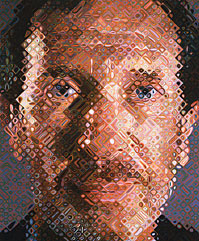
Arne Glimcher
Pace Wildenstein owner
by Chuck Close
Let us start with the images. They should be primary, after all.

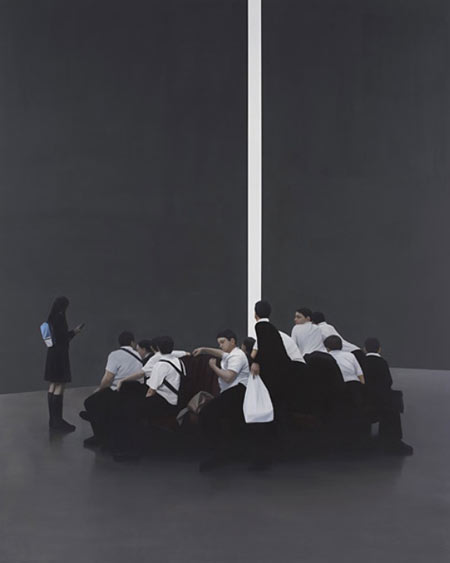
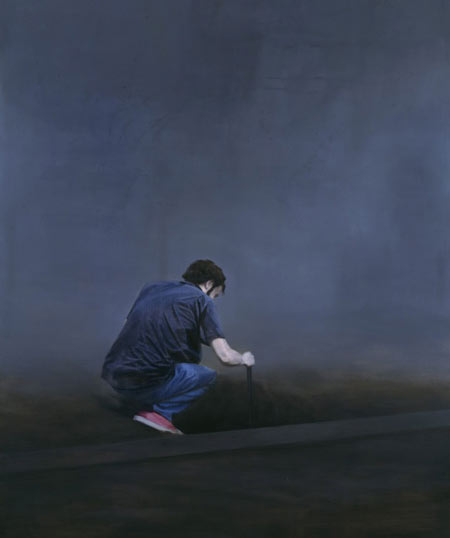
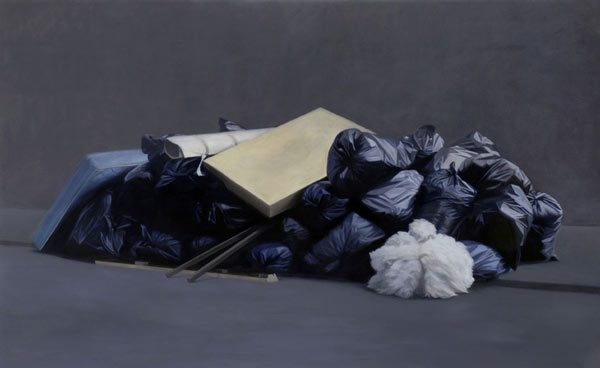
Next we will look at the publicity: “In Tim Eitel's emotionally complex and stirring paintings, the artist conflates fragments of images and memories of everyday life with print and film media, as well as the history of art. Using formal, realist painting techniques, Eitel creates disconnected worlds extracted from time. The artist isolates his anonymous subjects from their contexts, profoundly elevating the significance of every gesture and nuance. Past and present, memories, feelings, and associations converge, evoking ambiguous narratives which force viewers to reexamine their own perceptions of society and to see that which they often allow to become invisible.
Eitel has participated in more than fifty exhibitions worldwide since 2000. He has received a number of prestigious scholarships and awards throughout his career, including the Marion Ermer-Preis (2003) and the Landesgraduiertenstipendium, Saxonia, Germany (2002). He was granted an artist's residency in the International studio programme at Künstlerhaus Bethanien in Berlin in 2002. His work is part of numerous museum collections and important private collections worldwide.”
Do the images match the publicity? Not at all. I don't know about you, but I don't see anything “emotionally complex” or “stirring.” In fact, the paintings have been emptied of all emotion, I would assume purposefully. That is what makes them modern and allows moderns to look at them. If they had any real emotion in them, they wouldn't be modern and wouldn't be allowed into contemporary galleries. If they were emotional in any way, they would be dismissed as kitsch. They wouldn't be “contemporary realist” they would be “passé realist.”
Next we are told that Eitel conflates fragments of images and memories of everyday life with print and film media. No, he doesn't. As we can see from these images, what he does is paint from photos he takes. He takes a common photo of some everyday scene—one that is not even interesting—and then subtracts out the background, painting it in some shade of gray. I don't see anything that looks like it was painted from memory, or that looks like a memory, or that feels like a memory. Beyond that, we may ask what conflation is taking place here. A conflation would be a simultaneous use of painted images with printed images and/or filmed images. We don't have that here. We have images painted from photos, which is not a conflation, it is simply a use of a tool. These promoters don't even know what words mean. They not only know nothing about art, they know nothing about using the English language, beyond using it as a garbled tool of money-making.
Next we learn that Eitel “uses formal, realist painting techniques.” Does he? Not really. He probably uses modern shortcuts like painting from projection, which is likely why his images are poorly painted, flat, and look somewhat like a blurry photo. You can call that a realist painting technique, at a stretch, but it is nothing like the traditional techniques used by the old masters up until the end of the 19th century. Eitel's promoters want you to think he is a great talent, but he isn't. Thousands of high-school kids can paint this well, or better.
Just look at this picture of the artist in his studio: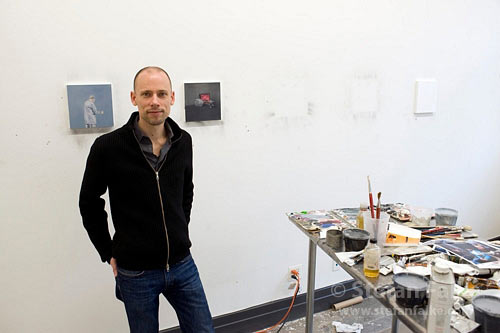
That's pathetic. In another pic—which I couldn't figure out how to borrow off the web—we see Eitel's method. He has a bunch of small photos taped to the wall. Nothing wrong with that, except that we real realists are crucified for using photos as reference. But the avant garde realists who benefit from Pace Wildenstein levels of promotion are praised to the skies for it. Using photos becomes a "conflation of memories, images, etc. with print and film media." Eitel is brilliant for using photos as reference, while I am just a cheater. But the bigger problem here is the starkness of Eitel's studio. Like Gerhard Richter's studio, it looks more like an OfficeMax being gutted and rewired than the studio of a creative person. We start with a large white cubicle, empty as the south pole. Then we add a cheap metal table, a laptop computer, a couple of back-issues of ARTnews, and some runny paints in dixie cups. Then we have some hardware-store disposable brushes, and one or two very large canvases, probably acrylic primed and slightly warped. So what, you say. The so what is that an artist's studio is a reflection of his mind, the embodiment of his creativity. A real artist's studio should be crammed full of interesting things to paint. It should be a beautiful room full of beautiful objects. It should also be a place for top-quality tools, hand-picked and cared for lovingly, molded by the touch of a master and patined by long use. Here are a couple of very different examples:

But the studios of these contemporary realists are antiseptic. You end up looking for the guy in a straightjacket who shares the space. Just off-camera he is squatting in the corner, swaying slightly.
This is just one more very obvious clue that these guys aren't real artists. They are computer technicians or bankers or stockbrokers that have been kidnapped, drugged, and photographed in somebody's insane idea of a studio. The CIA has erased all their memories and implanted the suggestion that they were artists. That implanted suggestion is all that remains in the conscious mind, which is why the studio looks like it has also been erased from the living world. Both "the artist" and his "studio" are just clipped and pixellated memory residues of a former time, buzzing eerily in a vast empty space. The white studio is a mirror of the white mind.
To continue this unintended theme of erasure and paucity and mental vacancy, we are told that Eitel creates "disconnected worlds extracted from time." Does that have any precise meaning? Any snapshot at Disneyland or Walmart could be said to be “extracted from time.” Any two photos pulled out of the garbage at Walgreen's could be said to be of “disconnected worlds.” Are we supposed to be impressed by “disconnected worlds extracted from time”? Shouldn't an artist be creating connections, not disconnections? We can find disconnected worlds just flipping through cable channels; why pay big money for it at Pace Wildenstein? Once again, it is mental patients who are supposed to be in "disconnected worlds extracted from time," not artists and their clients.
Then we are told that painting the background gray is done to “isolate his anonymous subjects from their contexts, profoundly elevating the significance of every gesture and nuance.” Good god, this writer should be writing political speeches. That deserves to be read from a Teleprompter. But it should lead us to a long line of questions: 1) Why would an artist want to paint anonymous subjects? Anonymity is impersonal and therefore unemotional. Can anyone be “stirred” by anonymous subjects in no context? 2) How does this isolating from context “elevate the significance of every gesture”? Wouldn't it logically do the opposite? Context is that thing that provides significance, so that we can read the meaning of the gestures. Anonymous figures out of context can only be insignificant, by definition. 3) Might the backgrounds be painted gray because it is easier to paint gray backgrounds? Setting figures naturally into backgrounds is damned difficult, and maybe Eitel just isn't up to it. That is what we would assume at a high school art show. Why do we assume differently here, just because Arne Glimcher or one of his hacks is supplying the text?
We are then told that all these fake conflations and convergences work by “evoking ambiguous narratives which force viewers to reexamine their own perceptions of society and to see that which they often allow to become invisible.” If those images above force you to re-examine anything, it should be your art gullibility. If they evoke in you “ambiguous narratives” and so on, you might seriously consider investing in a comprehensive psychiatric insurance policy. You might ask yourself how you got to this point, where you could read sentences like that and look at images like that, finding them intelligible or interesting.
All this leads us to ask the final question: if Eitel has been given all these awards, exhibitions, residencies, and so on, almost all of them before he reached 35, how did he do it? He joined Pace Wildenstein in 2006, when he was 35. PW is about as high as you can go, promotion-wise. Why did PW take him on? I will tell you. Everything except figuration had bottomed out by 2005, since the art world had been recycling all the various minimalisms and conceptualisms since 1906. The only thing not done to death was realism. Realism had been squirming in a shallow grave for about nine decades, and it was time to disinter the poor wretch and reinstall the zombie in the upperclass gallery. By 2006, artists like John Currin and Jenny Saville had already made big waves. Even Damien Hirst was doing realism (or paying others to do it for him). Plus, you have to remember that PW had been representing Alex Katz and David Hockney all along, so they knew the precise value of bad realism. Bad realism can be sold as modern, since all the faults can be re-interpreted as ambiguities. Good realism is just passé. It is passé because good realists endanger the entire market for art. Good realists, if seen for what they are—good—just make everyone else look bad and phony, so they have to be kept out.
In the second half of the past decade the top contemporary galleries have been sidling nearer and nearer to the top realist galleries, while keeping their prices way above them. Pace Wildenstein and Gagosian and so on look more and more like John Pence every year, and the reverse is also true. They have met in the middle, one might say, providing the client with neither real painting nor real politics. Instead, we have gotten a glut of paintings like those of Eitel: a faux realism, painted poorly and quickly from projection, that is both emotionless and talentless. The artist can't come up with a truly interesting subject, so he just paints from snapshots taken at random around the city. The gallery then props up these “paintings” with extended nonsense like we have pulled apart above, trying to create a relevance that is nowhere to be found in the actual images. Gerhard Richter pointed the way for Eitel, but Eitel has found a way to produce his own peculiar and awful nullities.
The convergence of realist gallery and contemporary gallery is precisely why galleries like Forum have struggled recently. It has been blamed on the economy, and that is part of it, but it is also because the realist galleries in that genre (so-called contemporary realism) now have to compete with Pace Wildenstein and Gagosian and the other very rich galleries that used to be avant garde. John Pence Gallery is no longer competing just with other realist galleries, it is competing directly with Damien Hirst's pimps and Eitel and Richter and Currin and so on. If it weren't for the fact that the modern gallery clients like to be seen spending enormous sums, Pence would probably already be defunct. Pence's saving grace is that he isn't in the same price range as PW. People who shop at PW aren't looking for bargains, but anti-bargains. They really don't want the same product at 1/10th the price. They want to pay a million dollars or more for their non-art.
So the answer is that Eitel made it for the same reason Katz and Pearlstein and Richter and Currin and the others made it: he was painting the right kind of realism at the right time. We may also assume he had connections. There are no good reasons for him to be famous, so I assume there are bad reasons.
To give that opinion of mine a bit more ballast, we will return to the paintings. I have torn apart the blurbs, and the images are even easier to dismiss. In the first, we find an empty bed. Not even a bed filled with syringes and vomit, as with Tracey Emin. Just a bed. Nor is it painted with some sort of anal “virtuosity”, as with Claudio Bravo. As I said before, it seems to have been stripped of all interest, including an interest in paint quality, paint handling, light effects, or composition. Someone really must write me, pointing out to me the stirring emotions I am missing there, the significant nuances, the ambiguous narratives. I can find no possible reason Eitel chose to paint that instead of anything else.
In the next image, we have a group of schoolchildren at the museum, doing absolutely nothing. They are not looking at works of art, unless the bright gap in the wall is intended as another ambiguous narrative, a work of art within a work of art. They are not talking to eachother. One girl appears to be texting. Possibly she is saying, “Get me out of this boring painting!” Only three of twelve faces can be seen, and those three are in profile, with eyes closed. The modern viewer will be able to read all sorts of supertexts and hypertexts over that, but to me it just means Eitel doesn't like to paint faces. They are too hard. Especially eyes. That just slows him down.
Then we have some guy digging a hole in the street. I assume it is the street, although the painting is so bad we aren't sure where he is. He may be on the Martian tarmac. Is his foot floating or on the ground? We aren't sure. By failing to paint the foot right, Eitel must be denying us context, so that we have to supply our own narrative. But if that is the case, I would have preferred he denied me all context, and all paint. I could then paint something interesting in my mind. Also, I must point out that Eitel has again given us a figure without a face. We are being fooled into thinking he can paint figures.
In the last painting, we have a pile of garbage, but it isn't even an interesting pile of garbage. This may be the remnants of Eitel's studio, which he has just very tidily and anally ejected from his house. We see the bed from image 1, which he no longer needs now that he has painted it: it wasn't even his—it was an anonymous bed, bought new from Target and then pitched before it could enjoy a slobber stain or a good boink. Then we see what may be parts of a cheap easel and a cheap portfolio. The white thing is unindentifiable. Is it a dead afghan hound? A pile of undyed muppet fur? An albino tribble? Everything else Eitel has conveniently hidden in Hefty, to avoid having to actually paint it.
Eitel doesn't waste much money on paint, does he? Not only are these painted very thin, we have almost no color. He only has to buy black and white.
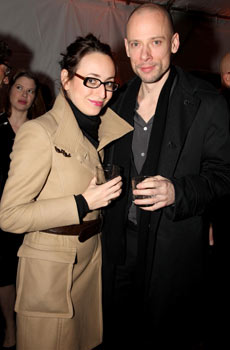
But enough of the paintings. They aren't the product anyway. The paintings are just wallpaper at the opening, where the product is Eitel getting his picture taken with Michael Ovitz or Martin Scorcese or somebody. Above we see him from the New York Social Diary, with Sophie Vigourous. If Glimcher can convince Ovitz or Geffen or some other Hollywood moron to put Eitel on the wall, everyone else in the social registers will want one, and the deal is done for several years. Look at Hockney, another of PW's “artists”. Hockney has never produced a real painting in his life, by the old standards, but he got in sweet with the Hollywood people early on, in some way we probably don't want pictures of, and he is still a staple of these parties and articles, written by the shallow and the clueless.
As with all other pursuits previously called intellectual, such as poetry, criticism, literature, and music, art is now a wholly fake field inhabited by human husks. The only nice thing I can think to say is that if the US ever has to purge its intellectuals, we will lose only about five people. It won't be much of a bloodbath.
Yes, the art of the worldwide rich is all a plastic world within a plastic world, a cosmos in a Hefty bag. A black hole enwrapping a void surrounded by a screaming waste. I have seen these people's houses, in Architectural Digest or something, and I would honestly rather live in a cave. That is the reaction of a true artist. No one really schooled by the Muses each night in his dreams could countenance living among such monstrosities and ghouleries as bedevil these persons' homes. They wonder why they need drugs to sleep and to get it up, why they require a constant tweeking by doctors and chiropracters and reiki masters and pharmacists, not understanding that they have created their own little hells among their own walls, with their own expensive purchases. Their minds and bodies are quite literally corroded away day by day by the uglinesses and vulgarities that assault them from every device and console and flat surface. I would be more comfortable on a bed of nails than in a living room filled with modern art, and so would they, if they only knew it.
The soul desires to be surrounded by beauties, and only the aliens know why these people have allowed themselves to be convinced otherwise. The truth is, there is one reason and one reason only that ugly things are now sold instead of beautiful things: they are easier to produce. Anybody can create paintings like the ones above, and that anybody can create them very quickly. But beautiful paintings take time, talent, and character. No matter how much technology is available, very few people can create them. Both the paintings and the artists are rare. No one ever tells you that anymore, although it is obvious and you already know it, because it is not considered good PR, in any market. It is not good PR at Pace Wildenstein because it conflicts with progressive politics, where everyone is equal. And it is not good even in realism, because realists make most of their money teaching. These realist teachers have to keep telling their students that art is something anyone can do, in order to generate more students. “All you need is my booklet and my patented palette and my 12-step process, and you too can paint like Leonardo!” It isn't good for business to tell students the truth: no amount of work will make you an artist if you aren't already an artist. Practice makes a born artist a better artist; it cannot make an artist out of a non-artist. Art is not equal access any more than the NBA is equal access. People do not have a right to be an artist, any more than they have a right to be President or to be 7 feet tall. Yes, all people have some sort of right or freedom to paint, if they like, just as they have the right to sing or dance or play baseball. But that doesn't mean they have the right to go on American Idol or to dance with the stars or play with the Yankees. Hockney seems to think he has a right to paint like Sargent, and it is very sad. His success with the fake galleries and the fake clients increases his feelings of unfairness, but there it is. He will never paint like Sargent because he is Hockney. Even if he learned the brushwork, he would still choose to paint something boring and ugly, and it would all be for nought.
Someone needs to tell all these rich and famous people that they are pathetic and deluded, and I guess that is my job. They blow their smoke and I blow it right back in their sorry faces. I am not impressed by their galleries or their homes or their stupid conversations. I don't care how much money they have or what other jack-offs they know or how many American Express titanium cards they have up their asses. Their movies suck, their songs suck, their art sucks, and their books suck. They look like idiots talking about themselves on Charlie Rose or Oprah or Letterman, and I would rather listen to the birds sing than go to a Hollywood party or Chelsea party. I would rather listen to goats fart than listen to those phony bastards talk about themselves. When was the last time any one of them created anything of beauty? As with Eitel, I have to ask, "Why are we listening to them?" Why are they famous? Why are they being interviewed? The pretty ones can sit there and shut up: they are prettier without talking. The rest of them can just fuck off.
If this paper was useful to you in any way, please consider donating a dollar (or more) to the SAVE THE ARTISTS FOUNDATION. This will allow me to continue writing these "unpublishable" things. Don't be confused by paying Melisa Smith--that is just one of my many noms de plume. If you are a Paypal user, there is no fee; so it might be worth your while to become one. Otherwise they will rob us 33 cents for each transaction.